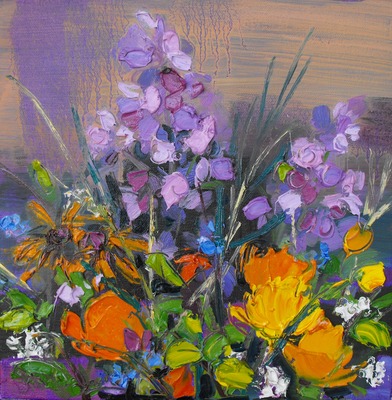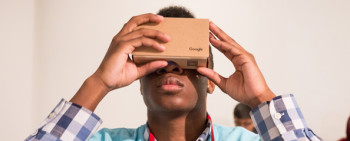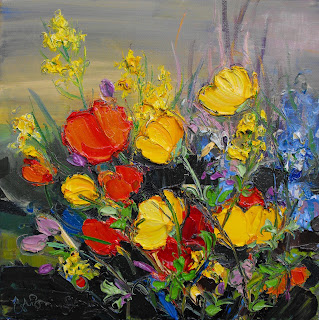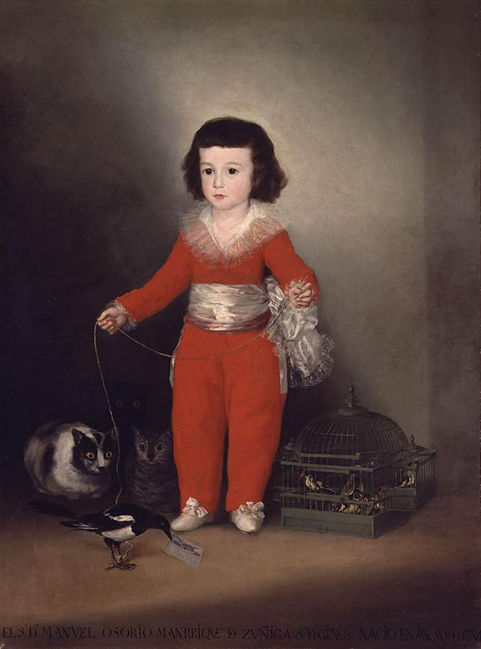Calendula in Bloom (Oil on canvas, 12 x 12)
Tuesday, 26 January 2016
Show Now Online!
Just a quick heads-up to say that my "From City to Sea" exhibition is now online, with over 40 paintings - take a look! Just click on the title below.
RSW - Connections: Scotland and Italy
As I have a painting in the show, I thought it a good idea to go along to the Lillie Art Gallery in Milngavie to see this exhibition by the Royal Scottish Society for Painters in Watercolour, which is open for another few weeks until the 18th of February.
The Lillie is a lovely space, with several large airy, well-lit rooms. The show itself is very impressive indeed, of a very high standard, with lots of big name Scottish artists demonstrating all manner of watercolour techniques. it's well-hung, easy to read and beautifully presented.
The show was pleasingly well attended on the day that I went, which was great for a weekday afternoon (although I took the photos without including the people, to give you an idea of the space).
However, on striking up conversations with the visitors, I found that they, like myself, were somewhat baffled by the title of the show. The catalogue sheds no light on the 'Scotland and Italy' theme, nor any introduction or background information on the Fabriano Collection. What is it? Who are the painters that are on show? They weren't Italian, so what was it all about? No-one had any idea.
When I submitted my piece, I thought very hard about the theme. How to represent Scotland and Italy in one painting? So I decided to go for a quintessentially Italian subject - and what could be more Italian and recognisable than the Colosseum, which I had recently revisited - and to paint it in a bold, Scottish style, with vigorous, expressive marks, lots of pattern-making, and vibrant colours in a restricted palette. Allora - Scotland and Italy!
About 10% of the artists in the show seemed to have the same idea. But, wondered the baffled visitors, what were the other 90% all about? Where were the 'Connections'?
I had to agree. Given that there was a bold and obvious theme, the actual content of the show seemed, whilst top notch, strangely unconnected.
Nevertheless, despite the furrowed brows of the public, they seemed to be very pleased with the show, and I would highly recommend a visit myself. If you'd like to see a wide range of watercolour styles and water-based media, then you get along and look at a masterclass of contemporary Scottish work.
Friday, 22 January 2016
Ai Weiwei 360
If you missed the amazing Ai Weiwei exhibition at the Royal Academy recently (you can read my blog about it HERE), then don't worry.
The Royal Academy have just released a pretty fabulous interactive tour of the exhibition, available online until November, with guides and information, which you can 'walk' round at your own pace and in any order you want.
So wherever you are, you can take an immersive tour of the
galleries, alongside commentary from the exhibition’s curators and
interviews with the artist himself.
AI WEIWEI 360 TOUR
There are introductions from RA Artistic Director Tim Marlow and WikiLeaks founder
Julian Assange, with a voiceover from Channel 4 News chap Jon
Snow. The tour consists of navigable 360º imagery, video and audio
channels, and a range of specially-created video helps you to discover
the meaning, context and technical detail of Ai Weiwei’s work.
This means you can not only explore Ai Weiwei 360 on a desktop, tablet or smartphone
using just your internet browser, but this is (apparently) the first exhibition
to be captured in photorealistic stereoscopic 3D, available on
both Samsung Gear VR and Google Cardboard. Yes. Google Cardboard.
Haven't times changed.
As I said, it's a great idea - imagine if you had a record like this of all great shows - walking through the Crystal Palace at the Great Exhibition, or the iconic Salon de Refuse.
It's also a completely different version of the show itself, creating a different virtual experience of the show. Like you're one of the surveillance cameras that watched Weiwei, except now you're watching the show remotely. That's a whole new layer of weird.
However, it's still a brilliant idea, so if you didn't make it to London, or even if you did see the exhibition, do take the opportunity to have a look at the show now!
"From City to Sea" Invites
Here's a quick look at the invites for my show which opens in a couple of weeks. They feature a Northern Ireland painting "Old School House, White Park Bay" on the front.
I'll be sending them out with the catalogues next week. In the meantime, the show will shortly be coming online, and you can click to see the paintings in the show by going HERE.
(If you'd like an invite and a catalogue for the show, let me know by dropping a line with your postal addfress to judith@jibridgland.com)
London Art Fair
Just back from a quick visit to the London Art Fair, which runs until Sunday at the Business and Design Centre in Islington.
It's a fabulous fair, with over 3 floors of top notch dealers exhibiting some great work. There's a really high standard of quality. It's been 4 years since I was last at the Fair, and I really was impressed.
For example, there is a lot of great Scottish work. Here's a mouth-watering Gillies watercolour with Ewan Mundy Fine Art. Can I have this one please?
William Gillies, Gruinyard Bay (Oil on canvas, 1939, £9750 with Ewan Mundy Fine Art)
There was also a fair number of Joan Eardley's sprinkled throughout the fair. This oil of tenements was again at Ewan Mundy.
Jopan Eardley, Tenements, Evening
This group were at the Castlegate House Gallery.
They included Glasgow Boy (Head) for £38,000.
Sea No 6, also £38,000.
...and A Country Road from 1957, which was £43,000.
There were also some fabulous contemporary Scottish prints, such as this wonderfully textural sugar lift at the Glasgow Print studio stand.
Marion McPhee, Humpback Whale IV
Plus many, many gems of modern British work, such as Henry Moore, David Bomberg, Laura Knight acrobat drawings...
Dame Laura Knight (Lena Boyle Fine Art)
...a beautiful, lyrical Peter Lanyon watercolour Cliff Grasses...
...and a watercolour by Elisabeth Frink, better known for her sculpture (but painted in very sculptural terms)...
Elisabeth Frink, Horse and Rider 1978 (Rollo Campbell Fine Art)
Here's one of Frink's bronzes, one of her Bird series (yours for £38,500). It was made in the 1950s, but looks as if it has come from the set of Star Wars. it has an aggressive, mechanistic feel to it, like the killing machine of Ted Hughes' contemporary Hawk Roosting poem come to life.
And oh, what's that behind it?
Yes, that's my paintings right there, to the left of the Elisabeth Frink, round the corner from the Henry Moore and Edouardo Paolozzi, and just along from the Cadells and Peploes.
This is my work on the Duncan R Miller stand (Stand 52) - Sun and Light Breeze, Bass Rock (oil on linen, 26 x 32)
and Grasses in the Wind, Camusdarach (Oil on linen, 26 x 32).
All in all, it's a very rewarding fair to visit, so if you love art and have the opportunity this weekend, do go along if you can.
Tuesday, 19 January 2016
New Paris Painting
Here's another autumn painting of Paris that's going to be in my London show.
Ile de la Cite (Oil on linen, 24 x 26)
It's from the Pont des Arts on the Seine near the Louvre (the one which used to have all the romantic love padlocks, but which have now mostly been taken away), looking towards Pont Neuf and the island in the middle of the Seine, Ile de la Cite. Notre Dame is down on the right.
Monday, 18 January 2016
At the Printers
The new catalogue for my solo show 'From City to Sea' is at the printers at the moment, and should be arriving next week. Very exciting! Can't wait to see it.
If you'd like a copy, and an invite to the show at Duncan R Miller Fine Arts, St James's, London, then drop me a line with your postal address to judith@jibridgland.com
The preview is on Thursday 11th February from 5.30pm. I'll be there, and it would be great to see you if you're able to come along!
This year, I will have around 35 brand new paintings in the show, with scenes of Scotland, Northern Ireland, Cornwall and London, and I have chosen to explore some very different and contrasting
types of landscape – "from city to sea".
Grasses in the Sand, Gulf of Mexico (Oil on linen, 12 x 12)
Those of you familiar with my work will know how much I love painting the sea and the rugged coastlines of Scotland, Cornwall and Northern Ireland. There’s something very exciting about the wildness of the wind and sea, and about land that has been weathered and buffeted by the elements.
These
landscapes have a real energy and timelessness about them, a beauty and a wild
intensity. So in this show there are
once again plenty of paintings of these familiar places, along with the
peaceful, broad expanses of beaches around the east coast at North
Berwick, and the deserted white and pink sands of Morar.
Whilst
I enjoy the continuity and familiarity of going back to the same places year
after year, I also look wherever I can for new ideas. I like my shows to read like a story, to have
something a little bit unexpected, to be full of surprising contrasts.
So
this year I have also explored the landscapes in cities. I wanted to contrast the ordered, controlled
landscapes within the heart of urban areas against the wild, untamed scenery
from the very edges of the country.
To
that end, I have visited many parks and gardens in a number of cities,
exploring the shapes and patterns of man-made landscapes. I took my cameras to locations such as Kew Gardens,
Hyde Park, Green Park and Hampstead Heath, experiencing
the parks at different times of year, especially as the leaves turned towards
autumn.
Cherry Trees, Kew Gardens (Oil on linen, 12 x 12)
I also made visits to the
glasshouses at both Kew and Edinburgh to study the waterlilies. Waterlilies
are a theme that I explored many years ago, and it’s a pleasure to return to them
afresh. Here I can juxtapose the calm
and intimate close-up experience of their beautiful, logical patterns, with the
powerful, exciting, energetically abstract shapes of waves on the shore, or the
wide, open expanses of empty beaches or huge skies.
Pink Waterlilies in Sunlight, Kew (Oil on linen, 26 x 32)
A good exhibition should take you on a journey, tell you a story. My show is therefore the story of a year of travel, of observing, recording, note-taking, and remembering, and it is also a story about what it is to be a Scottish painter.
Do hope you can come to the gallery and see the show! The exhibition runs until 9th March.
Sunday, 17 January 2016
More from the Easel...
Here's another little painting, fresh from the studio.
Autumn Colours, Hampstead Heath (Oil on linen, 12 x 12)
Friday, 15 January 2016
Today's Painting...
Here's a cheerful little something from today in the studio...
Yellow Flowers in Summer, Bass Rock (Oil on linen, 32 x 32)
Wednesday, 13 January 2016
The Story of Scottish Art
Hurrah!
Not only do we have a half-decent programme about a neglected subject, The Story of Scottish Art, but we have an actual artist competently presenting it (Lachlan Goudie), and he manages to speak about his subject in an engaging, intelligent, logical, informed way. And even does some painting and sketching of his own along the way.
Hurrah!
Here's the man himself, looking every bit like the cliched artiste at large (but he does rock a mighty fine waistcoat).
In this second episode, the story has jumped forward 600 years from the Picts to The Enlightenment of the 1700s, when forward-thinking artist Scots were unafraid to have many strings to their bows - architecture, engineering etc - and were fearless in depicting their sitters as real people, with insight and honesty. Step forward Allan Ramsay.
This is a self-portrait, and it's just a stunning, stunning thing (it was sold at Christie's just in 2008). The detail of the skin of the face is just astoundingly real - I've no idea how he did it. The painting shows a guy who's brimming with confidence but not arrogance, an intelligent man you'd like to meet and have a chat with. Although, if you're painting your self portrait as a kind of business card for potential clients, that's pretty much how you'd portray yourself.
See a clip about Allan Ramsay in Rome here.
Also in this episode was Horatio McCulloch, he of velvety Glencoe fame. This is the gloweringly sultry Mr McCulloch - twas ever thus that artists were mean and moody, eh? And he's rocking a mighty fine waistcoat as well, along with a saucy palette. All in all, it's quite a business card too.
Horatio McCulloch, Hill and Adamson, 1847
And this is Glencoe. I like to describe landscapes as self-portraits, and if ever a landscape WAS a self-portrait, this is it.
Horatio McCulloch, Glencoe (Oil on canvas, 1864)
McCulloch's depiction was very much a product of its Victorian time - defining Scotland in romantic, sublime terms, a wild, untamed place with just a hint of shortbread. It created Scotland as a brand, as a rugged playground for the rich. Feel free to shoot those pretty deer in the foreground, the local population won't bother you - they've all been handily cleared off.
Having said all that, it's a really wonderful painting in the flesh - beautiful, expressive, painterly, textural brushwork from someone who actually knew the landscape. I just love the mountains, because they really do have a velvety, tactile texture to them. It's very sensual. It draws you in and seduces you with its detail.
Looking forward to the next episodes!
Tuesday, 12 January 2016
London Art Fair
The first big fair of the year, the London Art Fair, opens next week at the Business and Design Centre in Islington, and looks like being a very exciting event as usual.
It's the UK’s premier Modern British and contemporary art Fair, and is set in a great venuw on 3 levels. I'll have new paintings on Stand 52, Duncan R Miller Fine Arts, ahead of my solo show (which opens on 12th February).
And I'll be there myself at lunchtime on Thursday 21st January. So if you're going along to the Fair, see you there!
Spring Flower Border (Oil on linen, 12 x 12)
If you'd like an invite to the preview of my solo show on Thursday 11th February, or a full colour catalogue, then email me your name and postal address to judith@jibridgland.com
Monday, 11 January 2016
Quick Quiz Answer
Well, see if you can guess after a few more clues. The same artist also painted these.

And then it gets a bit odd with giant puppets
...dismembered sheep...
...flying people..
and dismembered people
Goya didn't have to show the work, or sell it, or paint it with a client in mind, it was done only for himself. It had to conform to no-one else's agenda. It only had meaning for him, it had no viewer to communicate to. It therefore has an absolute, stripped back, naked honesty about it.
Was it Goya's own dog? Was it the only creature that understood him, that showed him loyalty and trust? Is the great empty negative space, filled only by the slightly threatening suggestion of a shadow, symbolic of the great void of emptiness that was his isolating deafness? There is certainly an unavoidable sense of isolation, of the colour and joy drained from life, of a mental anguish, and uncertainty.
However, I find pretty much all of Goya's work very strange and quite disturbing. Even the most conventional, the Naked and Clothed Maja, is disturbing. So is his still life of the meat Whilst it is a reasonably common subject, in Goya's version, the dismembered animal stares at you from its own death, giving a very disquieting dialogue between you, the viewer, and the subject of the still life. The meat is actually making silent, unblinking eye contact with you. The painting was executed at a time when there was a year-long famine, which also gives it a strange twist.
Maunuel Osorio Manrique de Zuniga 1787–88. Oil on canvas The Metropolitan
Museum of Art, New York

Clothed and Naked Maja 1797-1800
And then it gets a bit odd with giant puppets
The Straw Manikin, 1791-92, Oil on canvas, Museo del Prado, Madrid
...dismembered sheep...
Still Life, A Butcher's Counter 1810-12 Oul on canvas, Louvre
...flying people..
Fantastic Vision (1819-23)
and dismembered people
Disasters of War No 39 1810-20
In case you hadn't guessed, these are all by the Spanish artist Goya, and were painted at the end of the 18th/beginning of the 19th century.
The Dog, which I showed yesterday, was painted in 1819-23, and is one of his 'Black Paintings' - painted directly on the plaster of the wall of his house, and not intended to be seen. Here they are in situ.
They are a group of strange and disturbing paintings, with unclear, very personal meanings, painted when the artist was in his 70s, almost completely deaf, and going through a period of profound mental turmoil.
So The Dog is quite unlike anything else painted at the time.
So The Dog is quite unlike anything else painted at the time.
Goya, The Dog (Black Painting), (1819-23)
Goya didn't have to show the work, or sell it, or paint it with a client in mind, it was done only for himself. It had to conform to no-one else's agenda. It only had meaning for him, it had no viewer to communicate to. It therefore has an absolute, stripped back, naked honesty about it.
Was it Goya's own dog? Was it the only creature that understood him, that showed him loyalty and trust? Is the great empty negative space, filled only by the slightly threatening suggestion of a shadow, symbolic of the great void of emptiness that was his isolating deafness? There is certainly an unavoidable sense of isolation, of the colour and joy drained from life, of a mental anguish, and uncertainty.
However, I find pretty much all of Goya's work very strange and quite disturbing. Even the most conventional, the Naked and Clothed Maja, is disturbing. So is his still life of the meat Whilst it is a reasonably common subject, in Goya's version, the dismembered animal stares at you from its own death, giving a very disquieting dialogue between you, the viewer, and the subject of the still life. The meat is actually making silent, unblinking eye contact with you. The painting was executed at a time when there was a year-long famine, which also gives it a strange twist.
Yesterday, there was a programme on television about Goya and his series of etchings The Disasters of War, presented by Jake Chapman. Jake and Dino Chapman made a number of artworks based on the etchings, like this.
Jake and Dinos Chapman, Disaters of War (detail) 1993
They even scribbled on actual Goya etchings. I mean actually drew on them (which the Chapman brothers call 'rectifying' them. Let us be the judge of that.)
Jake and Dinos Chapman, Reworking of Goya's The Disasters of War
Anyway, in the programme, Secret Knowledge, Jake Chapman showed us around various galleries to show us Goya's work, went to Zaragoza where Goya was born, and had a look at Goya's actual plates for his Disasters of War series of etchings. Which was very interesting and informative.
Unfortunately, having banged on in the past about poor art history programmes which are presented by non-art historians, and non-artists, I have to say that, having endured Jake Chapman's woffle, perhaps artists don't make the best and most informative of presenters either. Perhaps it's because artists aren't taught art history in art schools. Perhaps they aren't taught how to do research properly or how to present material as lectures. I'm just guessing - I've not been to art school.
The programme guide says that "As Jake works on a new 'Disasters of War' model in his London studio, he
explains why for him there is a fundamental conflict at the heart of
Goya's art - in their gruesome detail his images seem to celebrate
violence rather than protest against it. Jake explores this
contradiction that art history has chosen to ignore, and explains how it
tells us something profound about the way we see ourselves and our
past."
Mr Chapman certainly talked - he talked a lot. And he said a lot. And he had some fantastic, hands-on original material to talk about.
But good grief, I've no idea what he was saying at all. I'm an artist, and I've got a degree in art history, and I was sitting in front of the television thinking 'What did he say? Er...what on earth did that mean?'. He didn't actually explain anything at all.
Because, sadly, effective communication of his subject was not Mr Chapman's strong point. He had lots of big words, from the viewpoint of an actual art practitioner, so it should have been full of illuminating insight and meaning. Er....it wasn't. he didn't even know when he'd produced his own Disasters of War work (1993, fact fans), which was what he went to the Tate with a camera crew to talk about.
Wonderful Goya, gobbledegook Chapman.
Subscribe to:
Posts (Atom)














































.jpg/1280px-Vision_fant%C3%A1stica_o_Asmodea_(Goya).jpg)




